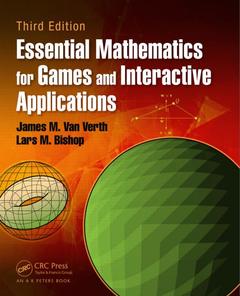Essential Mathematics for Games and Interactive Applications (3rd Ed.)
Auteurs : Van Verth James M., Bishop Lars M.

Expert Guidance on the Math Needed for 3D Game ProgrammingDeveloped from the authors? popular Game Developers Conference (GDC) tutorial, Essential Mathematics for Games and Interactive Applications, Third Edition illustrates the importance of mathematics in 3D programming. It shows you how to properly animate, simulate, and render scenes and discusses the mathematics behind the processes.
New to the Third EditionCompletely revised to fix errors and make the content flow better, this third edition reflects the increased use of shader graphics pipelines, such as in DirectX 11, OpenGL ES (GLES), and the OpenGL Core Profile. It also updates the material on real-time graphics with coverage of more realistic materials and lighting.
The Foundation for Successful 3D ProgrammingThe book covers the low-level mathematical and geometric representations and algorithms that are the core of any game engine. It also explores all the stages of the rendering pipeline. The authors explain how to represent, transform, view, and animate geometry. They then focus on visual matters, specifically the representation, computation, and use of color. They also address randomness, intersecting geometric entities, and physical simulation.
An Introduction to Creating Real and Active Virtual WorldsThis updated book provides you with a conceptual understanding of the mathematics needed to create 3D games as well as a practical understanding of how these mathematical bases actually apply to games and graphics. It not only includes the theoretical mathematical background but also incorporates many examples of how the concepts are used to affect how a game looks and plays.
Web ResourceA supplementary website contains a collection of source code, supporting libraries, and interactive demonstrations that illustrate the concepts and enable you to experiment with animation and simulation applications. The site also includes slides and notes from the authors? GDC tutorials.
Representing Real Numbers. Vectors and Points. Linear Transformations and Matrices. Affine Transformations. Orientation Representation. Interpolation. Viewing and Projection. Geometry and Programmable Shading. Lighting. Rasterization. Random Numbers. Intersection Testing. Rigid-Body Dynamics.
James M. Van Verth is a software engineer at Google, where he works on GPU support for the Skia 2D Graphics Library. He has worked for Insomniac Games, NVIDIA, and Red Storm Entertainment and, for the past 17 years, he has been a regular speaker at GDC, teaching the tutorials "Math for Game Programmers" and "Physics for Game Programmers." He received a BA in math/computer science from Dartmouth College, an MS in computer science from the State University of New York at Buffalo, and an MS in computer science from the University of North Carolina at Chapel Hill.
Lars M. Bishop is an engineer in the Handheld Developer Technologies group at NVIDIA. Prior to joining NVIDIA, he was the chief technology officer at Numerical Design Limited, leading the development of the Gamebryo3D cross-platform game engine. He received a BS in math/computer science from Brown University and an MS in computer science from the University of North Carolina at Chapel Hill.
Date de parution : 10-2015
19.1x23.5 cm
Thèmes d’Essential Mathematics for Games and Interactive Applications :
Mots-clés :
Fragment Shaders; Source Code Library; Barycentric Coordinates; Vertex Shader; Texture Coordinates; Per-vertex Attributes; Single Precision Floating Point; Affine Space; Transformed Basis Vectors; Shader Code; View Space; Vector Space; View Vectors; Point P0; Unsigned Int; Mipmap Level; Depth Buffer; IEEE Float Point; Complete Fragments; Partial Fragments; Axis Aligned Bounding Box; Hermite Curves; Vertex Buffer; CDF; Mantissa Bits



